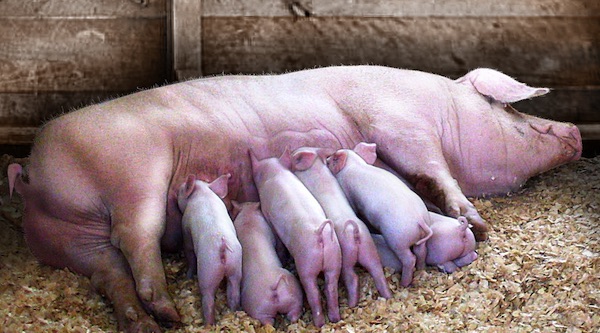Even before Governor Kristi Noem’s CAFO bribes can really kick in, South Dakota is already enjoying a bacon boom. According to the latest USDA National Agricultural Statistics Service report, on September 1, South Dakota had 2.00 million hogs and pigs in the barn, up 16% from a year ago and up 7% from June 1 of this year:
Breeding hog inventory, at 265,000 head, was up 8 percent from September 1, 2018, but unchanged from last quarter. Market hog inventory, at 1.74 million head, was up 18 percent from last year, and up 8percent from last quarter.
The June–August 2019 South Dakota pig crop, at 1.49 million head, was up 15 percent from 2018. Sows farrowed during the period totaled 126,000 head, up 8 percent from last year. The average pigs saved per litter was a record high 11.85 for the June–August period, compared to 11.10 last year [USDA-NASS, “South Dakota Hog Inventory up 16 Percent,” 2019.09.27].

Hmm… farmers are up and raising a lot more pork on their own… with supply growing, would someone remind me why state government needs to interfere in the meat market by offering its treats to fatten those piggies?
If we could sustain the current yearly growth rate, South Dakota’s hog population would exceed 10 million by 2030. If Governor Noem’s CAFO bribes boosted that growth rate by even four percentage points, to give us 20% annual growth in the piggie population, then by 2030, we’d have almost 15 million bacon packs a-hoof.
Random Land-Use Stats: If we banned CAFOs as environmental menaces and raised all two million of our current hogs and pigs outdoors where they can walk around and root with their buddies, we’d could maintain good rotation and pasture quality on 100,000 acres… not quite a ninth of Hand County, or maybe the footprint of two big wind farms.
On the bright side, one modest swine cafo would use more fresh water and create more waste than all the immigrants allowed into South Dakota in one year. Plus, the swine would have less economic impact over their lifetime as immigrants.
iowa DNR reported for at least the third time in 2 weeks, a manure spill in NW iowa. This one near Hawarden. The last two were near Sioux Center and Hull, if memory serves. All spills were close to tributaries of the BIg Siou-er River.
Mike, maybe a manure spill in Des Moines, up on the hill in that that white, domed building would get the legislator’s attention. Maybe?
Well, you can’t stand to drive across northwest Iowa for the smell so I guess So Dak can’t wait to get in on that.
Cory, even though that report make’s it look like these are hogs raised by independent farmer producers I’ll bet that with some research you will find that these hogs are being raised in a contract arrangement with big integrator’s.
For every direct job a swine operation creates it creates almost one off payroll job. Our economy will die without livestock production.
Keep the jobs coming.
Sam2 expanding Medicaid does it better with moar jobs and many millions in economic activities.
What happens when a catastrophic disease sweeps swine cafos and no amount of antibiotics will stop it? What about all the discarded medications in swine waste and feed get flushed into our clean water streams?
I noticed in Wisconsin when people’s water wells gfet polluted by manure handlersw, the state under Walker changed the rules to mak it easier to pollute drinking water instead of curbing law breakers.
That picture, in no way, exemplifies a true pig CAFO. You are way too nice. As for employees, the 30% turnover rate is indicative of the types of jobs we don’t need in South Dakota. This is not livestock production, it’s a factory producing livestock. But what’s interesting is that not one proponent, owner, of one of these huge facilities, lives near them.
Maybe SD farmers should try this, meat vending machines:
is.gd/X7UHYm
(It’s a real thing!)
Sam2, you sound like Mark Mickelson, talking as if CAFO swine production is the only enterprise that creates jobs. Farming pre-CAFOs did that, too, and did it better, creating more jobs for Main Street clothiers, cobblers, grocers, movie houses, dance halls, not to mention all the extra teachers we needed to teach all those small family-farm kids. The old model of agriculture seems to have supported more jobs in town than CAFOs do.
Cory is right. Sam2 assumes a 1 to 1 job creation, but that requires money to circulate in South Dakota. On a per pig basis, corporate factory farming does away with jobs, and the money made is largely made by corporation outside South Dakota. That’s why when corporate ag takes over, small towns end up dying.
One way to think about it is that fewer jobs are created per ton of pig feces. As Cory indicates, more farmers mean more Main Street jobs. The hog glut is not necessarily good. More supply and less demand means prices tank, which results in less money to create jobs.
Show me the IMPLAN analysis on CAFOs versus local farmers market-focused operations putting out equivalent amounts of product, then tell me where a CAFO bribe—er, GOED incentive tax forgiveness—would generate more economic development.
Ah: every dollar spent at Oklahoma farmers markets in 2002 generated $1.78 in total economic activity. The IMPLAN jobs multiplier was 1.41… and farmers’ markets don’t require giant poop pits and put water quality at wetlands at risk.
Imagine if instead of one guy raising 10,000 pigs, you had a hundred guys each raising a hundred pigs. Imagine each pig farmer has a spouse and two kids. That’s 200 kids for the school district, 400 eaters for the local grocery, 400 customers for the local movie house.